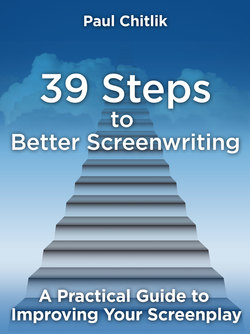Читать книгу 39 Steps to Better Screenwriting - Paul Chitlik - Страница 13
На сайте Литреса книга снята с продажи.
ОглавлениеStep 7
Conflict and Scene Construction
In my seminars, I usually mention two or three times per session that there must be conflict in every scene because it’s the one thing that new writers almost universally forget. In expository scenes, they just figure that getting the information out there is enough, but it’s not really. The basic rule (and this is one of the few rules in screenwriting) is that there must be conflict in every scene.
The element most new (and many experienced) screenwriters leave out of their scenes is conflict. Without conflict, there is no drama. Without drama (even in a comedy), there is no story. Without conflict, there is no movement. No change. Conflict is the key element of the scene.
The central characteristic, the one element that every scene needs, is conflict.
Okay, I have said it more than three times, which is the minimum number of repetitions for something to sink in. I’ll probably do it again by the end of the chapter, just in case.
Just as there are barriers (conflict) for the protagonist to overcome over the length of the film, so, too, there are smaller conflicts in each scene. In the beginning of a scene, somebody wants something. Somebody else either tries to prevent him from getting that, or wants something in opposition. The scene, then, is about the struggle. Learning what each one (or more) wants is the beginning of the scene. The struggle to get it is the middle. One or the other wins the struggle. That’s the end of the scene. Somebody’s got to win, somebody’s got to lose. Even in a comedy. Especially in a comedy.
Every major player in a scene has an objective — he/she wants something. Usually, each character wants something different. Hence the conflict.
We must also know what the emotion of that character is at the beginning of the scene, what his/her attitude is, what’s his long term goal. There’s a helluva difference between a scene that starts off with everyone pissed off at each other from the get go and one that starts with laughter. If you know your characters, you’ll know what their emotions are at the beginning of the scene — are they happy, sad, angry? — and what will happen to them during the scene. Unless they have cause to change (they may or may not), they should maintain that emotion throughout the scene. Actors look at scenes this way (or the good ones do), and they look for hints the writer has given them.
We also need to know what the subject and purpose of the scene is. Yes, it’s to move the story forward, first and foremost. But it may also be to shed some light on a character, to reveal information, to provide an obstacle. Know what you want to get across with your scene.
Then, and most importantly, know what each character in your scene wants to achieve. There’s the writer’s objective and the character’s objective. If you know exactly what each character wants and how he needs to try to achieve that, you will achieve your writer’s objective as well.
How do you do that in a scene which is wholly expository? Use exposition as ammunition. Aaron Sorkin is a master at this, as anyone who watched The West Wing knows. How many times did we see two characters walking down a hallway arguing about something, trying to prove their point, while at the same time giving the audience a shit load of exposition? Rhetorical question. Answer — hundreds. There was a lot of data to be thrown at the viewer. If you don’t do it in an interesting way, it will cause the viewer to “click!” to another channel.
Same for a movie.
What about a love scene? Is there conflict in that?
Ever been in love? Of course there’s conflict there. One person wants to move at a certain pace, the other has a different pace in mind. One wants to be on top, the other prefers that position. One wants to go to bed, the other can’t wait for the bed. You figure it out, but, trust me, the more conflict in the love scene, the hotter it’s going to be so long as they both want to be in a love scene. Again, you need to know your characters. And a thwarted love scene is also interesting and moves the story in a different way.
So, no matter what the purpose of the scene is — to move the story or to delineate character — and no matter what the writer’s objective is, the single most important element of a scene is conflict. No conflict, no scene.
